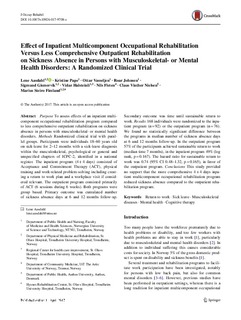| dc.contributor.author | Aasdahl, Lene | |
| dc.contributor.author | Pape, Kristine | |
| dc.contributor.author | Vasseljen, Ottar | |
| dc.contributor.author | Johnsen, Roar | |
| dc.contributor.author | Gismervik, Sigmund Østgård | |
| dc.contributor.author | Halsteinli, Vidar | |
| dc.contributor.author | Fleten, Nils | |
| dc.contributor.author | Nielsen, Claus Vinther | |
| dc.contributor.author | Fimland, Marius Steiro | |
| dc.date.accessioned | 2017-10-26T08:14:44Z | |
| dc.date.available | 2017-10-26T08:14:44Z | |
| dc.date.created | 2017-04-13T15:56:14Z | |
| dc.date.issued | 2017 | |
| dc.identifier.citation | Journal of occupational rehabilitation. 2017, 1-10. | nb_NO |
| dc.identifier.issn | 1053-0487 | |
| dc.identifier.uri | http://hdl.handle.net/11250/2462270 | |
| dc.description.abstract | Purpose: To assess effects of an inpatient multicomponent occupational rehabilitation program compared to less comprehensive outpatient rehabilitation on sickness absence in persons with musculoskeletal- or mental health disorders.
Methods: Randomized clinical trial with parallel groups. Participants were individuals 18–60 years old on sick-leave for 2–12 months with a sick-leave diagnosis within the musculoskeletal, psychological or general and unspecified chapters of ICPC-2, identified in a national register. The inpatient program (4+4 days) consisted of Acceptance and Commitment Therapy (ACT), physical training and work-related problem-solving including creating a return to work plan and a workplace visit if considered relevant. The outpatient program consisted primarily of ACT (6 sessions during 6 weeks). Both programs were group based. Primary outcome was cumulated number of sickness absence days at 6 and 12 months follow-up. Secondary outcome was time until sustainable return to work.
Results: 168 individuals were randomized to the inpatient program (n=92) or the outpatient program (n=76). We found no statistically significant difference between the programs in median number of sickness absence days at 6 and 12 months follow-up. In the outpatient program 57% of the participants achieved sustainable return to work (median time 7 months), in the inpatient program 49% (log rank, p=0.167). The hazard ratio for sustainable return to work was 0.74 (95% CI 0.48–1.32, p=0.165), in favor of the outpatient program.
Conclusions: This study provided no support that the more comprehensive 4+4 days inpatient multicomponent occupational rehabilitation program reduced sickness absence compared to the outpatient rehabilitation program. | nb_NO |
| dc.language.iso | eng | nb_NO |
| dc.publisher | Springer Verlag | nb_NO |
| dc.rights | Navngivelse 4.0 Internasjonal | * |
| dc.rights.uri | http://creativecommons.org/licenses/by/4.0/deed.no | * |
| dc.title | Effect of Inpatient Multicomponent Occupational Rehabilitation Versus Less Comprehensive Outpatient Rehabilitation on Sickness Absence in Persons with Musculoskeletal- or Mental Health Disorders: A Randomized Clinical Trial | nb_NO |
| dc.type | Journal article | nb_NO |
| dc.type | Peer reviewed | nb_NO |
| dc.description.version | publishedVersion | nb_NO |
| dc.source.pagenumber | 1-10 | nb_NO |
| dc.source.journal | Journal of occupational rehabilitation | nb_NO |
| dc.identifier.doi | 10.1007/s10926-017-9708-z | |
| dc.identifier.cristin | 1465048 | |
| dc.relation.project | Norges forskningsråd: 238015 | nb_NO |
| dc.description.localcode | © The Author(s) 2017. This article is distributed under the terms of the Creative Commons Attribution 4.0 International License (http://creativecommons.org/licenses/by/4.0/), which permits unrestricted use, distribution, and reproduction in any medium, provided you give appropriate credit to the original author(s) and the source, provide a link to the Creative Commons license, and indicate if changes were made. | nb_NO |
| cristin.unitcode | 194,65,20,0 | |
| cristin.unitname | Institutt for samfunnsmedisin og sykepleie | |
| cristin.ispublished | true | |
| cristin.fulltext | original | |
| cristin.qualitycode | 1 | |

